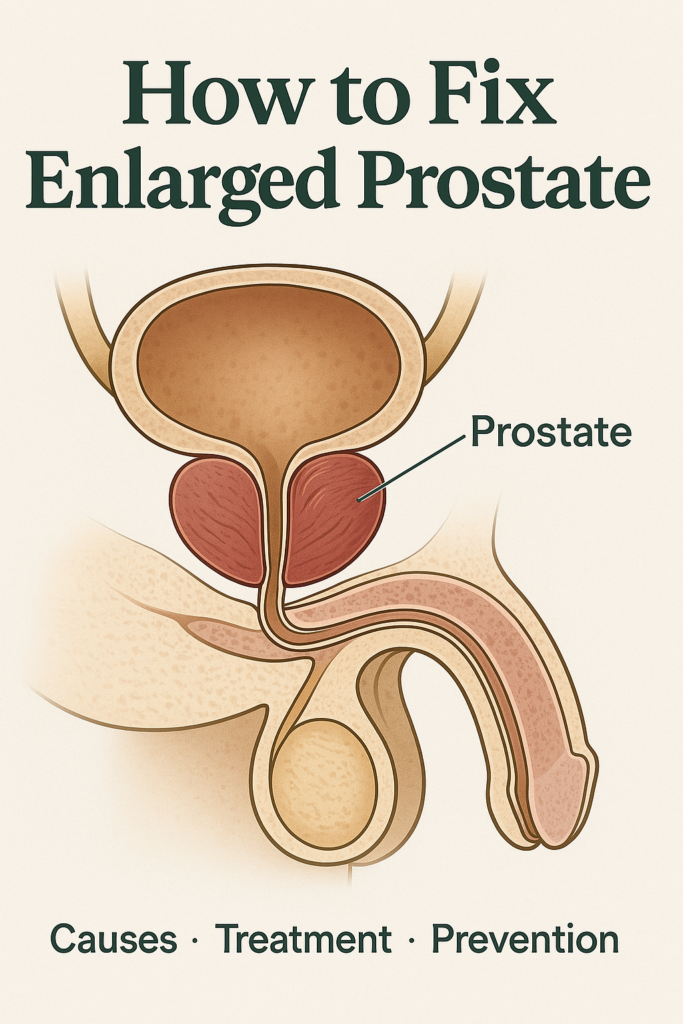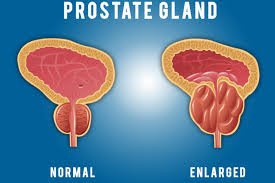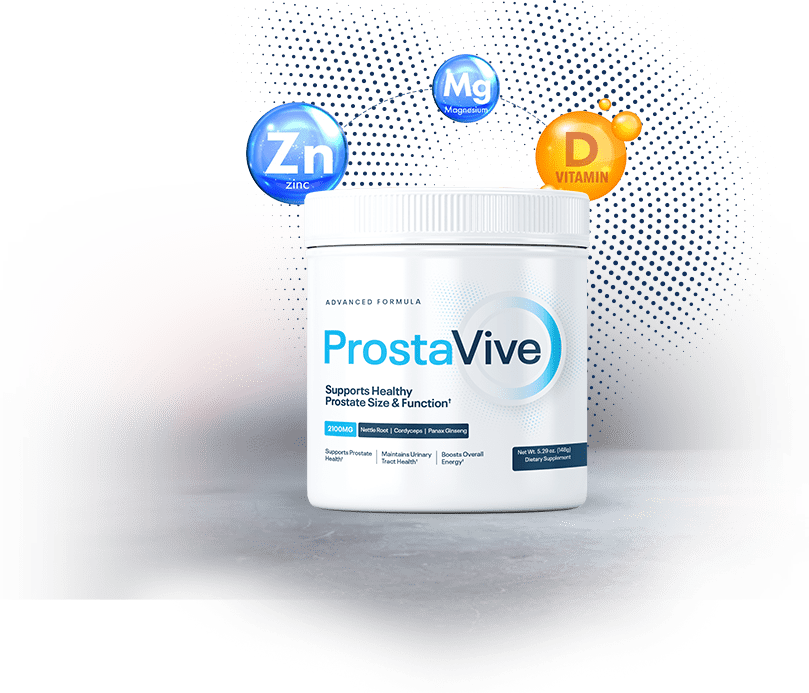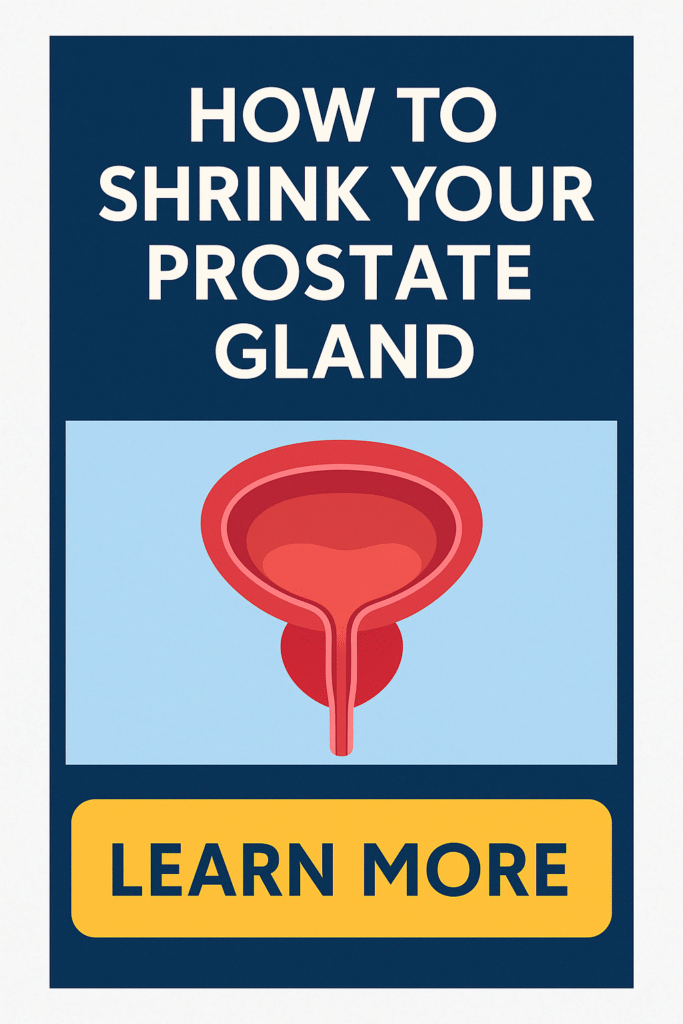How To Shrink Your Prostate Gland

How To Shrink Your Prostate Gland: Imagine reaching a point in life where frequent trips to the bathroom become as normal as your morning coffee, all thanks to an enlarged prostate. For many aging men, this is a daily reality due to a condition known as Benign Prostatic Hyperplasia (BPH), which affects millions globally. Understanding BPH is the first step in tackling this common issue, and it’s crucial to explore all possible solutions.
Traditional medical interventions often take the front seat in managing enlarged prostate symptoms. However, integrating natural solutions, such as supplements and lifestyle changes, can be equally impactful. This article navigates through various treatments, from prescription medications to the benefits of practices like yoga and specific supplements like ProstaVive.
By combining these approaches, men may find effective strategies to alleviate symptoms and improve quality of life. Join us as we delve into how you can shrink your prostate gland using both medical pathways and natural remedies, including a closer look at the role of ProstaVive.
Understanding Benign Prostatic Hyperplasia (BPH)
Take Control Naturally
BPH symptoms are common — but you don’t have to accept them. Consider a natural path to comfort and confidence with ProstaVive.

How To Shrink Your Prostate Gland: As men advance in age, it’s common for prostate-related issues to arise, most notably Benign Prostatic Hyperplasia (BPH). This condition is characterized by the non-cancerous enlargement of the prostate gland, which can lead to a range of urinary symptoms and significantly impact a man’s quality of life. Although BPH is generally not life-threatening, it can cause discomfort and lead to complications like urinary tract infections if left untreated. Fortunately, there are a variety of treatment options available, ranging from medical to natural remedies, to help manage prostate health effectively. In this article, we will delve into a combination of approaches, including lifestyle changes and supplements like ProstaVive, that can alleviate symptoms and improve overall well-being. By understanding and addressing the root causes of BPH, it is possible to achieve a better quality of life and reduce the impact of this common condition on daily activities.
Prevalence and Risk Factors
Benign Prostatic Hyperplasia is a prevalent condition among aging men, particularly those over the age of 40 to 50. As men age, the likelihood of experiencing prostatic hyperplasia increases, with studies indicating that nearly half of men in their 50s and up to 90% in their 80s show signs of an enlarged prostate. The primary risk factors for developing BPH include aging and shifts in hormone levels, such as a decrease in testosterone. Genetics also play a significant role; if BPH is a common issue in your family, the risk of having an enlarged prostate is higher. Additionally, lifestyle factors such as obesity can exacerbate the condition. Understanding these risk factors is crucial in proactively managing prostate health and preventing the escalation of symptoms.
Common Symptoms
The symptoms of Benign Prostatic Hyperplasia can often affect daily activities and sleep quality, which is why recognizing them early is vital. Commonly, men will experience a weak urine stream, a frequent and urgent need to urinate, especially at night, and a sensation of incomplete emptying of the bladder. These symptoms can make routine tasks uncomfortable and disrupt peaceful sleep. Many men may also notice an increase in the time it takes to initiate urination. These urinary tract symptoms, while common, can vary in severity and should be discussed with a healthcare provider to explore appropriate treatment options. Understanding the symptoms allows for timely management and improved comfort in everyday life.
Diagnosis and Screening Procedures
Diagnosing Benign Prostatic Hyperplasia accurately is crucial for determining the most suitable treatments. The process typically begins with a thorough medical history and physical exam, including a digital rectal exam to assess prostate size and identify any irregularities. Blood tests, such as the Prostate-Specific Antigen (PSA) test, can help rule out prostate cancer. Additionally, an ultrasound may be utilized for further examination of excess prostate tissue and to evaluate the urinary tract system. Early detection of BPH can significantly affect the flow of urine and prevent complications like bladder stones or urinary retention. By recognizing symptoms and undergoing regular screenings, men can maintain better prostate health and prevent worsening conditions. Regular check-ups enable men to manage their symptoms proactively and maintain an improved quality of life.
Medical Interventions
Looking for a Gentler Option?
Before jumping into surgery or medication, many men explore natural alternatives. ProstaVive may offer a supportive step forward.

How To Shrink Your Prostate Gland: For men living with an enlarged prostate, medically known as benign prostatic hyperplasia (BPH), a variety of medical interventions offer relief from troublesome urinary symptoms. BPH is a common condition as men age, leading to issues such as frequent urination, weak urine stream, and even urinary retention. Understanding the different treatment options available can help improve prostate health and overall quality of life. Medical interventions range from medications to surgical procedures, each suited for varying degrees of prostate growth and accompanying symptoms. The right approach depends on factors like the severity of symptoms, personal health risks, and lifestyle. Below, we delve into specific medical treatments that can help manage this condition effectively.
Prescription Medications
When it comes to handling BPH, prescription medications offer a reliable starting point. Doctors often recommend two primary drug classes: alpha-blockers and 5-alpha-reductase inhibitors. Alpha-blockers work by relaxing the bladder neck and bladder muscles, thereby improving the flow of urine and mitigating symptoms like frequent urination. On the other hand, 5-alpha-reductase inhibitors address the root problem by reducing the excess prostate tissue and thus slowing prostate enlargement. While these medications can be beneficial, it is important to note that their effects are not instantaneous. Consistent use is required for several weeks to months before notable improvements in urinary symptoms are seen. Also, some side effects might occur, including dizziness or retrograde ejaculation, highlighting the importance of regular medical supervision during treatment.
Minimally Invasive Procedures
For men who seek alternative solutions to daily medication, minimally invasive procedures like Rezum and UroLift have emerged as effective options. These treatments are less invasive than traditional surgery but still deliver medical-grade results. Rezum uses water vapor therapy to reduce excess prostate tissue, thus relieving pressure on the urethra and improving urine flow. This approach typically requires short recovery periods, making it a compelling choice for active individuals. The UroLift system, meanwhile, physically lifts and holds the enlarged prostate tissue away from the urethra, ensuring better urine flow with minimal downtime. Both procedures involve minimal risks and can significantly improve bladder function and reduce urinary tract symptoms, providing a bridge between medication and surgical solutions.
Surgical Options
When BPH symptoms become severe and significantly impact one’s quality of life, surgical interventions may be necessary. Among the most established options are Transurethral Resection of the Prostate (TURP) and laser therapy. TURP involves removing parts of the prostate to unblock urine flow, offering substantial relief from urinary symptoms for many patients. Laser therapy similarly targets and removes excess prostate tissue using focused light energy, providing precision and minimizing bleeding. These surgical treatments are generally reserved for more advanced cases of prostate hyperplasia where other measures have failed. While more invasive than medication or minimally invasive procedures, surgery can drastically improve symptoms and is often recommended when immediate and extensive intervention is required.
Natural Remedies and Supplements
Support Your Body Naturally
Natural solutions like ProstaVive combine plant-based ingredients that may help relieve symptoms without harsh side effects.

How To Shrink Your Prostate Gland: When it comes to improving prostate health, many men are looking beyond traditional medical treatments and exploring natural remedies. The popularity of these alternatives reflects a growing desire to address benign prostatic hyperplasia (BPH) with fewer side effects and more holistic approaches. Natural remedies and supplements can be an appealing option as they often combine readily with lifestyle adjustments for enhanced benefits. In this section, we’ll delve into some of the most effective natural options for supporting prostate health. From herbal allies like Saw Palmetto to powerful plant compounds such as Beta-Sitosterol, and nutrient-rich foods like those rich in Lycopene, Omega-3, and Zinc, these solutions offer a promising complement to conventional medical strategies. Consider how these options can be integrated into a comprehensive plan to help reduce prostate enlargement and its accompanying symptoms, enhancing your quality of life.
Saw Palmetto
Saw Palmetto is one of the most well-known herbal remedies for mild symptom relief in men experiencing an enlarged prostate or prostatic hyperplasia. Extracted from the berries of the Serenoa repens plant, Saw Palmetto has been used for centuries in traditional medicine to promote urinary health and alleviate related symptoms. Some studies suggest that it may be effective in reducing urinary tract symptoms like weak urine stream and frequent urination by inhibiting a key enzyme that contributes to prostate growth.
However, it’s important to note that Saw Palmetto should not be viewed as a cure for BPH. Its benefits are typically mild and can vary among individuals, making it a better option for those with less severe symptoms. While Saw Palmetto is generally well-tolerated, the results can be modest compared to pharmaceutical interventions. Combining Saw Palmetto with other treatments, including lifestyle modifications and supplements like ProstaVive, may yield more comprehensive relief and improved prostate health.
Beta-Sitosterol
Beta-Sitosterol is a plant-based compound that has gained attention for its potential to improve urinary flow in men with BPH. This substance is a phytosterol commonly found in plant oils, nuts, seeds, and certain vegetables, offering natural support for prostate health without the side effects often associated with synthetic drugs. Clinical studies have shown that Beta-Sitosterol can enhance the flow of urine, reduce the feeling of urinary retention, and help manage urinary tract symptoms.
ProstaVive, a well-regarded supplement in the realm of natural prostate health, includes Beta-Sitosterol as a key ingredient. By incorporating Beta-Sitosterol, ProstaVive aims to maximize prostate health benefits and support a healthy urine flow, potentially making urinary symptoms less bothersome. This supplement can be an excellent addition to lifestyle changes focused on reducing prostate tissue enlargement and enhancing overall urinary function.
Foods Rich in Lycopene, Omega-3, and Zinc
How To Shrink Your Prostate Gland: A balanced diet rich in specific nutrients can play a pivotal role in supporting prostate health and hormonal balance. Foods enriched with Lycopene, Omega-3 fatty acids, and Zinc are particularly beneficial in this regard. Lycopene, a powerful antioxidant found abundantly in tomatoes, has been linked to reduced prostate growth and improved overall prostate health. Regularly consuming tomatoes, as well as watermelon and pink grapefruit, can therefore be a valuable part of prostate support.
Omega-3 fatty acids, found in fatty fish like salmon and mackerel, as well as flaxseeds and chia seeds, help reduce inflammation and support hormonal health. They are crucial for maintaining the health of prostate glands and may contribute to mitigating excess prostate tissue expansion.
Zinc, a mineral vital for prostate health, can be sourced from foods like pumpkin seeds, nuts, and shellfish. Adequate Zinc levels can support hormone levels and potentially alleviate some urinary symptoms by strengthening bladder muscles and supporting the bladder neck. By incorporating these nutrient-rich foods into your diet, you can help manage symptoms exacerbated by prostatic hyperplasia and foster a healthier prostate.
Lifestyle Changes
Combine Habits with Support
Healthy habits are powerful, but pairing them with a targeted supplement like ProstaVive can boost your results.

How To Shrink Your Prostate Gland: Addressing an enlarged prostate, or benign prostatic hyperplasia (BPH), often requires a multifaceted approach to effectively shrink the prostate gland, alleviate urinary symptoms, and enhance overall quality of life. It’s increasingly clear that lifestyle modifications can play a crucial role in managing and even reversing prostate growth. By incorporating a combination of exercise and dietary changes, men can potentially reduce the size of the prostate and the severity of their symptoms. Lifestyle changes can help improve blood flow, reduce inflammation, and support better hormone balance, all of which are essential for prostate health. With the right strategies, men can expect to see improvements in urinary flow and reductions in frequent urination—common issues associated with BPH. By undertaking these changes alongside medical treatments and supplements like ProstaVive, there’s a greater likelihood of achieving significant prostate relief. Let’s explore effective lifestyle strategies that promise relief from this common concern.
Exercise and Physical Activity
How To Shrink Your Prostate Gland: Integrating regular exercise into your routine is a powerful and natural way to address prostate enlargement and associated urinary symptoms. Exercise, particularly aerobic activities such as walking, jogging, or cycling, enhances blood flow, which is vital for reducing prostate inflammation and promoting better urinary tract health. Engaging in these activities helps strengthen bladder muscles and the surrounding pelvic area, which can mitigate symptoms of weak urine stream and improve urine flow.
Pelvic floor training, often called Kegel exercises, specifically targets the muscles supporting the bladder neck and prostate glands. These exercises can be particularly beneficial in managing urinary tract symptoms by improving control over urination and reducing urinary retention. Consistent training can lead to significant improvements in the tone and function of these muscles, resulting in better management of urinary function.
Overall, exercise not only contributes to prostate health but also boosts overall well-being, helping to prevent the further risk of complications such as bladder stones and urinary tract infections. By adopting a regular exercise regime, men can vastly improve their quality of life while addressing the challenges posed by an enlarged prostate.
Dietary Modifications
How To Shrink Your Prostate Gland: Dietary changes present a powerful avenue for managing prostate health, influencing hormone levels, and reducing prostate tissue growth. A diet that focuses heavily on whole foods and plant-based ingredients can deliver essential nutrients that promote a healthy prostate. These diets are typically rich in antioxidants, vitamins, and minerals that combat inflammation and excess prostate tissue.
Avoiding processed foods and refined sugars is critical since these foods can exacerbate symptoms and contribute to weight gain, further stressing the urinary system. By choosing whole grains, fruits, vegetables, and lean proteins, men can support better hormone regulation, reduce the symptoms of prostatic hyperplasia, and improve the flow of urine.
A plant-based diet not only supports prostate health but also benefits cardiovascular health and energy levels, leading to a more vibrant life. This approach emphasizes a comprehensive upgrade in lifestyle, with nutrition playing a pivotal role in achieving sustained prostate gland health.
Reducing Red Meat and Caffeine Intake
How To Shrink Your Prostate Gland: Reducing or eliminating red meat and caffeine can provide significant relief for those suffering from BPH. Red meat, often high in saturated fats, can worsen symptoms and promote inflammation in the prostate tissue. It’s advisable to replace red meat with healthier protein alternatives such as fish, poultry, or plant-based proteins like legumes and nuts.
Similarly, caffeine—the stimulant found in coffee, tea, and certain sodas—can irritate the bladder and worsen urinary symptoms. By overstimulating the bladder muscles, caffeine can increase the urgency and frequency of urination, leading to disruptive symptoms particularly at night. Reducing caffeine intake, or choosing caffeine-free options, can help alleviate these symptoms and improve bladder control.
Substituting red meat and caffeine with healthier, less irritating alternatives contributes to a less inflamed and better-functioning prostate. These dietary adjustments are strategic steps towards diminishing the symptoms that accompany prostate enlargement and improving your quality of life. Taking these steps ensures a proactive approach to maintaining a healthy prostate and urinary system.
Alternative Therapies
Balance Your Approach
Alternative therapies work best when supported from the inside out. ProstaVive may complement your holistic routine.

How To Shrink Your Prostate Gland: When it comes to managing the symptoms of an enlarged prostate, also known as benign prostatic hyperplasia (BPH), alternative therapies can play a significant role. While traditional medical treatments like 5-alpha reductase inhibitors and surgical procedures offer effective solutions, many men find additional relief through holistic approaches. These therapies aim to address prostate health by reducing hormone-driven prostate growth and enhancing overall quality of life. Engaging in practices like yoga, relaxation techniques, and bladder training exercises can not only mitigate urinary symptoms but also promote a sense of well-being. By incorporating alternative therapies alongside conventional treatments, individuals may enjoy a balanced and comprehensive strategy for managing their prostate health.
Yoga and Relaxation Techniques
Stress and tension are more than just mental hurdles—they can contribute to physical ailments, including the exacerbation of prostate symptoms. Elevated stress levels can influence hormone production, making symptoms of prostate enlargement worse. By engaging in yoga and relaxation techniques, men can find a helpful balance that positively impacts both their mental and physical health. Yoga promotes flexibility and balance, especially in the pelvic region, which can ease urinary tract symptoms and support the flow of urine. Relaxation techniques, such as deep breathing and meditation, help regulate hormone levels, potentially reducing prostate tissue growth and enhancing the function of bladder muscles. These practices provide a dual benefit of physical exercise and mental calm, making them ideal components of a holistic approach to improve prostate health.
Bladder Training Exercises
How To Shrink Your Prostate Gland: Bladder training exercises represent a practical and non-invasive approach to combating the urinary symptoms associated with BPH. By focusing on timed urination and structured bladder control, these exercises aim to enhance the bladder’s capacity and the flow of urine. The main goal is to prolong the time between bathroom visits, thereby reducing frequent urination and improving quality of life. Regular practice of bladder training exercises can strengthen bladder neck and bladder muscles, potentially easing symptoms like weak urine stream and urinary retention. These exercises offer a proactive way to address urinary tract symptoms, diminishing the reliance on medications and reducing the risk of urinary tract infections. By incorporating bladder training into daily routines, men with prostatic hyperplasia can find relief and regain control over their urinary habits.
Importance of Early Medical Consultation
Don’t Wait for Symptoms to Worsen
Talk to your doctor — but also take charge. Daily use of ProstaVive may help reduce symptoms before they escalate.

How To Shrink Your Prostate Gland: Benign Prostatic Hyperplasia (BPH) is a prevalent condition that affects a significant number of aging men globally. As men age, they often experience uncomfortable urinary symptoms, which can significantly impact their quality of life. From frequent urination to a weak urine stream, these signs should not be ignored. Early detection through regular medical check-ups can lead to more manageable symptoms and a considerably improved prognosis.
Acting promptly through a physical or rectal exam can help identify prostatic hyperplasia before symptoms worsen. Early consultation with a healthcare provider allows for a comprehensive assessment, including hormone levels, the state of the bladder muscles, and the flow of urine, paving the way for effective treatment options such as 5-Alpha reductase inhibitors or surgical procedures.
An integrative approach, combining medical advice with natural strategies, often yields the best results. Supplements like ProstaVive, along with lifestyle changes, have shown promise in aiding prostate health. Together, these methods can help reduce excess prostate tissue, minimize bladder stones, and improve urine flow. Remember, identifying prostate growth early is key to maintaining both prostate health and overall quality of life, making early medical consultation imperative.
Managing Risks and Monitoring Progress
Track and Improve Consistently
Journaling your symptoms? Add ProstaVive to your routine and monitor how natural support may shift the results.
How To Shrink Your Prostate Gland: Navigating the journey of managing benign prostatic hyperplasia (BPH) involves understanding both the potential risks of treatment options and the progress related to your symptoms. As prostate gland enlargement can significantly affect urinary functions and overall quality of life, it’s important for individuals to stay informed about the possible side effects of various treatments while actively monitoring their symptoms. This comprehensive approach ensures that decisions are made with thorough knowledge and attention to personal health outcomes. From considering medication risks to engaging in consistent symptom tracking, an informed strategy can vastly improve prostate health. Regular check-ups remain crucial, and they allow for adjustments in treatment plans and lifestyle habits. This balanced method offers an opportunity to address BPH effectively.
Potential Risks of Treatments
How To Shrink Your Prostate Gland: When evaluating treatment options for an enlarged prostate, understanding potential risks is essential. Medications such as 5-Alpha reductase inhibitors can be effective in reducing prostate tissue and alleviating urinary symptoms. However, they may lead to side effects like retrograde ejaculation, decreased libido, or changes in hormone levels. These side effects should be weighed against the potential benefits, particularly for those with severe BPH symptoms affecting their daily activities.
In some cases, surgical procedures might be necessary to remove excess prostate tissue. While these interventions can significantly relieve urinary retention or severe symptoms, they also come with risks such as bleeding, infection, or urinary tract symptoms post-surgery. Less invasive options may present fewer immediate risks, yet they might require a longer timeline to achieve desired results.
Discussing all treatment possibilities with a healthcare provider is critical. This allows individuals to consider personal health goals and existing conditions while balancing the risks and benefits. Regular communication ensures that any adjustments can be made swiftly, optimizing both prostate health and quality of life.
Monitoring Symptom Improvement
Symptom improvement for BPH highly depends on sustained efforts to monitor and document changes over time. Keeping a detailed journal of your urinary symptoms such as frequency, urgency, and urine flow helps track progress and identify patterns. Include notes on lifestyle changes or when you start a new supplement like ProstaVive, as this information provides context and clarity on what strategies are contributing to improvements.
Routine check-ups with your healthcare provider are invaluable. These appointments offer a chance to review your symptom journal together, ensuring a clear overview of your prostate health. Providers can then suggest modifications to treatment plans, increase or decrease the use of certain supplements or medications, and recommend lifestyle adjustments if necessary.
The combination of diligent self-monitoring and regular professional evaluations forms the backbone of effective symptom management. By maintaining an active role in tracking improvements, individuals empower themselves to make informed decisions regarding their prostate health and quality of life.
Supplement Spotlight: ProstaVive and Holistic Support
Why Choose ProstaVive?
Trusted by thousands, ProstaVive offers clean, plant-powered support for prostate and urinary health. Try it today.

How To Shrink Your Prostate Gland: For countless men, the journey through aging comes with its own set of challenges, particularly when it involves an enlarged prostate, or Benign Prostatic Hyperplasia (BPH). This condition brings along a host of urinary symptoms, from frequent urination to a weak urine stream, that can significantly affect one’s quality of life. Fortunately, there are countless treatment options, both medical and natural, available to help manage these uncomfortable urinary symptoms. One promising approach is the combination of holistic methods and supplements, like ProstaVive, to maintain prostate health and ease urinary tract symptoms. This article sheds light on the benefits of integrating ProstaVive, a science-backed supplement, along with making key lifestyle changes. Whether you’re considering 5-Alpha reductase inhibitors, exploring surgical procedures, or interested in incorporating herbal supplements like ProstaVive, understanding these options helps empower you to reclaim control over your urinary health and overall wellbeing.
What Is ProstaVive and How It Helps

ProstaVive is a powerful supplement meticulously designed to support prostate health, especially when tackling prostate enlargement or prostatic hyperplasia. Featuring beta-sitosterol, a plant extract known for its anti-inflammatory properties, ProstaVive proves to be more than just another name in the market. It actively assists in reducing the excess prostate tissue that can cause symptoms to worsen, like blocked urine flow or urinary retention. By addressing these issues, it significantly improves the flow of urine. Additionally, the unique blend of plant extracts in ProstaVive facilitates hormone balance, leading to a more stable quality of life by reducing urinary tract infections and minimizing the dreaded experience of retrograde ejaculation. ProstaVive thus offers a synergistic approach, working harmoniously with the body’s natural rhythm to curb unwanted prostate growth and support prostate glands holistically.
How to Integrate It Into Your Routine

Incorporating ProstaVive into your daily routine is simple yet effective. To unleash its full potential, it’s recommended to follow the dosage instructions provided on the product label. Typically, taking ProstaVive twice daily with meals ensures optimal absorption and maximal benefit. Consistency over an extended duration amplifies its effects, making it an essential part of a well-rounded prostate health regimen.
For enhanced results, consider coupling ProstaVive with an improved diet rich in fruits, vegetables, and healthy fats. A diet that is both balanced and nutrient-rich supports bladder muscles and hormone levels, contributing to better prostate health. Regular physical activity, like walking or cycling, also enhances the effectiveness of ProstaVive by promoting proper fluid intake and reducing urinary tract symptoms.
By merging the routine use of ProstaVive with dietary adjustments and exercise, you lay the groundwork for sustained improvement. This holistic effort not only aids in managing the symptoms of an enlarged prostate but ensures a proactive approach toward long-term bladder neck health and overall vitality.
Final Thoughts and Recommendations
Take the First Step Today
Consistency is key. Start with small habits, good nutrition, and consider ProstaVive to support your journey to relief.
How To Shrink Your Prostate Gland: Understanding your symptoms is the first step towards managing an enlarged prostate. Recognize signs like frequent urination, weak urine stream, and the sensation of incomplete bladder emptying. Combining natural and medical strategies yields the best results for improved prostate health and quality of life.
Engage in regular exercise to keep blood flow to your prostate healthy. Equally important is maintaining a nutrient-rich diet that includes fruits, vegetables, and whole grains. Healthy eating supports a balanced hormone level, crucial for reducing prostate tissue growth. Stay hydrated with proper fluid intake but reduce consumption near bedtime to help manage urinary symptoms.
Consider using quality supplements like ProstaVive, which can complement your lifestyle changes and contribute to shrinking your prostate gland. Consistency in these approaches is key.
In summary:
- Understand Symptoms: Be aware of what changes to look for.
- Combine Approaches: Integrate both natural and medical strategies.
- Lifestyle Changes: Prioritize exercise and a healthy diet.
- Consider Supplements: ProstaVive may support your efforts.
With dedication, real improvement is possible, leading to less frequent urination and improved urine flow.





